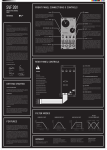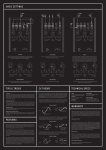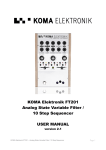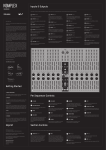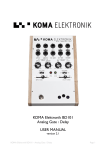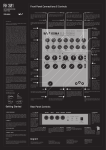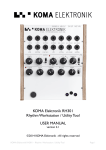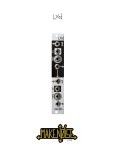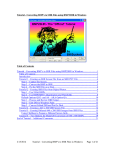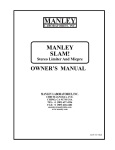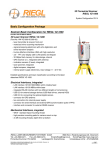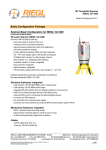Download You can the PDF manual
Transcript
SVF 201 ANALOG STATE VARIABLE FILTER _ USER MANUAL FRONT PANEL CONNECTIONS & CONTROLS Cutoff (CV Input) Cutoff We are KOMA Elektronik, we come from Berlin, a town filled with musicians, producers, artists and remixers. Music is everywhere. We make music ourselves as well, sometimes successful, sometimes less successful, but we have a good time doing so. And that for us is what it’s all about: the mere fun of creating sounds nobody else made before; the fun of crossing all borders and let your imagination go, the fun of exploring musical boundaries and not looking back! Our filter resembles that vision: compact, yet powerful, the SVF-201 is a state variable filter for the Eurorack modular synthesizer system. Its circuit is built up with optical parts (vactrols) delivering excellent studio audio quality and an unique warm analogue sound. The module uses parallel mounted PCBs so it can be used in skiffs as well as in big cases, the total depth is less than 4 cm. The SVF-201 comprises 4 audio outputs that can be used independent of each other at the same time, a High Pass, Band Pass, Low Pass and the unique first ever CV’able Mix Out, which allows you to sweep continuously through the other three outputs by means of a knob and control voltage. Now wire up that filter and get funky! 2 7 Resonance (CV Input) CV input for resonance (Q) modulation. It has the same specifications as the Cutoff CV input. 3 vieleicht 8 Defines the amplitude of the signal that will travel into the filter. At the counter-clockwise (CCW) position there will be no signal going into the module at all, at around 9 o’ clock the signal will be at unity gain and at full clockwise (CW) position the signal will be boosted by about +6dB (Audio Input) AUDIO IN 4 Select (CV Input) CV input to select which output will be present on the Mix Out audio output. This CV input accepts 0 – 5V (unipolar). If there is no CV signal sent into the input in the Select jack, the attenuator acts as a normalled CV source from 0 – 5V for manual sweeps through the filter types. 9 Audio input to the filter. There’s plenty of gain here, so take care when setting the input level if you do not want to distort your signal. Overdriving the input can get you amazingly rich and experimental sounds though, so try it out once and see if you like it! (Audio Outputs) AUDIO Out RESONANCE Sets the Q of the filter, better known as resonance. The resonance of a filter determines the gain increase of the signal at the cutoff frequency. Set it low (CCW) to leave the signal gain at cutoff frequency at zero and turn it CW to hear plenty of resonance at the given cutoff frequency. Be aware of the fact that the filter will start self-oscillating when you are at or near maximum resonance! CV input for cutoff modulation. This input reacts to bipolar CVs, internally only a 5V peak-to-peak signal is processed, so every CV signal exceeding a voltage of 5Vpp will have to be attenuated to use the full range of the CV input. Input Attenuator / Gain We tried to make this module just as versatile as our other products and are confident we succeeded in that! Before you get started, please let us introduce ourselves to you… 6 Sets the cutoff frequency for the filter, simultaneously for all three filter characteristics. The full CCW position sets the cutoff frequency to the lowest and the full CW position to the highest frequency. Dear KOMA user, Thanks for purchasing one of our Eurorack modules: the SVF-201 Analogue Vactrol State Variable Filter! We are very happy you decided to add a nice shade of white (with a backlit knob) to your Eurorack Modular system! 1 Mix Out (Audio Output) The Mix Out is a special output of the SVF-201 which contains all three of the above outputs (LP, BP and HP). You can sweep continuously through these three outputs with a control voltage signal from 0 – 5V. This output has more internal gain than the three different single outputs, so signals taken from this output will have more overdrive / distortion than their respective partners. The signal levels themselves are identical though. 5 These are the three outputs for the corresponding filter characteristics. All three outputs are available at the same time without the need to switch anything around. When changing the cutoff frequency or the resonance of the filter you change these features for all of the outputs simultaneously. REAR PANEL CONTROLS All the best from Berlin, 1 The KOMA Elektronik Team +5V rail choice If you have a +5V power supply on your bus board rails and you want to use it with the KOMA Elektronik SVF201 then you can change the second jumper setting from ‘Onboard’ to ‘Bus’. Don’t worry, the two +5V rails can never be connected together, regardless of how you place the jumper. Warning! Please do GETTING STARTED 2 not touch or change the four trimmers on the If you have access to an ISP programmer and you are familiar with programming micro controllers you can use the 6-pin ISP header for connecting your programmer to the module. You will find the pre-loaded code as well as some alternatives on our homepage at www.koma-elektronik.com top as they are already set to best filter behaviour 1. Unpack your new gadget and it is complicated The package comes with the SVF-201 filter module, a 16-pole ribbon cable with connectors, a small bag with four screws and washers for front panel mounting and this manual. to reset them after you First off; be sure that the bus board of your system is unpowered. Take the connector cable and insert it into the bus board of your modular system. Be very careful when doing so because it is easy to shift the connector and place it incorrectly. The red marked side needs to be connected on the lower side of a Doepfer bus board and on the marked side of the module (-12V rail). If attached correctly the keyed header will have the right orientation for keyed power systems (e.g. uZeus). See the rear panel picture for more clarity. 3. Power up Power up your system and check if all supply rails are up and running (+/-12V and possibly +5V), often there are indication LEDs on the bus board showing if the rails are working properly. When the power is connected properly, a white light – a nice nimbus - underneath the big Cutoff knob should light up. FEATURES 3 turned them (also just a safe yourself the hassle 4 and stay away from these trimmers! LED Corona If you don’t like the white light around the Cutoff knob simply take out the jumper above ‘LED Corona’ (and try not to lose it!). little bit), so please just 2. Connections ISP programming header for Mix Out Red stripe here! POWER CONNECTION Always make sure you align the red stripe on the power connector to the red stripe marker on the module. To be extra safe, make sure that the cable you are using is correctly wired, which means that one connector faces up and the other down when you hold the cable in front of you with the flat side up. -12V Gate CV +5V +12V GND GND GND -12V FILTER MODES LOWPASS (LP OUT) BANDPASS (BP OUT) Amplitude The use of the FT201 is pretty straight forward. There is the CUTOFF knob with which you set the cutoff frequency for the filter, simultaneously for all three filter characteristics. Fully counter-clockwise sets the cutoff frequency to the lowest and fully clockwise to the highest frequency. HIGH PASS (HP OUT) MIX OUT (LP/BP/HP MIXED OUT) The RESONANCE knob sets the Q of the filter, better known as resonance. The resonance of a filter determines the gain increase of the signal at the cutoff frequency. Set it to low (CCW) to leave the signal gain at cutoff frequency at zero and high (CW) to hear plenty of resonance at the given cutoff frequency. Be aware of the fact that the filter might start self-oscillating when you are at or near maximum resonance. The MIX OUT is a unique output that combines all filter types. You can sweep through from lo pass to band pass to hi pass with the SELECT potentiometer. The SELECT potentiometer is also able to be controlled via CV. IMPRINT KOMA Elektronik GmbH is a subsidiary company of KOMA Elektronik B.V. Vertretungsberechtigte Geschäftsführer / Managing Director: Christian Zollner & Wouter Jaspers Sitz der Gesellschaft / Registered Office: Berlin, Germany Registergericht / Court of Registration: Amtgericht Berlin-Charlottenburg Registernummer : HRB 145453 Umsatzsteuer ID / VAT ID: DE285522050 KOMA Elektronik GmbH Mahlower Strasse 24 12049 Berlin-Neukölln Germany BASIC SETTINGS AUDIO IN AUDIO out LFO IN AUDIO IN 3 OUT to channel mixer AUDIO out AUDIO IN AUDIO out AUDIO IN AUDIO out DISTORTED LOWS 3 CHANNEL MIXER OSCILLATOR SUB BASS RESONANCE FILTER TYPE SWEEP When the input gain is all the way up, the signal is distorted along with high resonance, creating a gritty sound. Take each output channel into its own channel on a mixer to blend between each filter type manually. Patch the HI PASS Audio Output back into the AUDIO Input to create an oscillator. When using the HI PASS output at a very low cutoff and high resonance, sub bass frequencies are added around the Q frequency. Patch an LFO into the SELECT CV input to sweep through the different filter types creating completely new sounds! CV THEORY TIPS & TRICKS WARRANTY The concept of control voltage (CV) is not hard to understand: instead of turning a knob on your pedal, you simply connect a voltage – the control voltage – to the corresponding CV input that does the job for you. All of the CV inputs theoretically accept control voltages from -100V to +100V though a range from -5V/-12V/-15V to +5V/+12V/+15V is more common and usable. Using the Input The Input Attenuator / Gain control defines the amplitude of the signal that will travel into the filter. At a counter-clockwise (CCW) position there will be no signal going into the module at all, at around 9 o’ clock the signal will be at unity gain and at full clockwise (CW) position the signal will be boosted by about +6dB. KOMA Elektronik warrants its products to be free of defects in materials / workmanship and conforming to specifications at the time of shipment for a period of two years from the date of purchase. During the warranty period, any defective products will be repaired or replaced at KOMA Elektronik’s option, on a return-to-factory basis. This warranty only covers defects that KOMA Elektronik determines are no fault of the user. Using the Mix Out Returning Your Product? The Mix Out is a special output of the SVF-201 which contains all three of the outputs (LP, BP and HP). You can sweep continuously through these three outputs with a control voltage signal from 0 – 5V. The diagram on the front side of this manual (under FILTER MODES, far right) shows the corresponding loudness curves of the filter characteristics in correlation with the CV input. Low pass appears at 0.25V to 2.25V, pure bandpass between 2.25V and 2.75V and from 2.75V to 4.75 you’ll get high pass as an output signal. All outputs crossfade into each other. You must obtain prior approval in the form of an RMA (Return Material Authorization) number from KOMA Elektronik before returning any product. Email [email protected] to request the RMA number. All products must be packed carefully and shipped with all the originally sent content. Sorry, the warranty will not be honored if the product is not properly packed. Once you have received the RMA number and carefully packed your product, ship the product to KOMA Elektronik and include your return shipping address. BIPOLAR CV SIGNALS The incoming bipolar CV signal is shifted around the voltage that you select with the corresponding knob. Example: if you insert a -5V to a +5V sine wave while adjusting the bias: BIPOLAR CV SIGNALS What will we do? How to clean your SVF 201 Clean the front panel with a cloth and rubbing alcohol. TECHNICAL SPECS A similar thing happens to unipolar CV signals: their point of origin (0V) is shifted by the amount set with the corresponding knob. In other words: you add the voltage of your knob to the voltage of your incoming unipolar CV signal. UNIPOLAR CV SIGNALS Casing 2mm Aluminum front panel, powder coated white with silkscreen printing. Dimensions 12 HP / 40mm depth. Shipping Weight 250 gram / 0.55 lbs. Power requirements 80 mA @ +12V. 11 mA @ -12V. Once received, we will examine the product for any obvious signs of user abuse or damage as a result of transport. If the product has been abused, damaged in transit or is out of warranty, we will contact you with an estimate of the repair cost. Warranty work will be performed and KOMA Elektronik will ship and insure your product to your address free of charge. How to initiate a warranty return Please initiate your warranty online by sending an email to [email protected]. If you do not have web access, fill out your personal information on a letter and mail to: KOMA Elektronik GmbH Mahlower Straße 24, 12049 Berlin-Neukölln Germany


